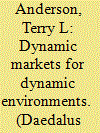| Srl | Item |
| 1 |
ID:
139822


|
|
|
|
|
| Summary/Abstract |
Static models used in economics and ecology ignore dynamic processes at work in both human and natural systems. In the case of water management, whether for quantity or quality, static models fail to connect changing human demands on water systems with changing supplies due to short-run climate variations and long-run climate change. Water markets provide a way of connecting human demands to nature's supplies through prices, which signal values and scarcity. For water markets to make this connection, water rights must be well-defined, enforced, and tradeable. When they are, entrepreneurs are able to meet old and new demands on water ecosystems in novel ways, as examples in this essay illustrate.
|
|
|
|
|
|
|
|
|
|
|
|
|
|
|
|
| 2 |
ID:
132616


|
|
|
|
|
| Publication |
2014.
|
| Summary/Abstract |
Energy lies at the backbone of any advanced society and constitutes an essential prerequisite for economic growth, social order and national defense. However there is an Achilles heel to today×s energy and technology relationship; namely a precarious intimacy between energy and the fiscal, social, and technical systems it supports. Recently, widespread and persistent disruptions in energy systems have highlighted the extent of this dependence and the vulnerability of increasingly optimized systems to changing conditions. Resilience is an emerging concept that offers to reconcile considerations of performance under dynamic environments and across multiple time frames by supplementing traditionally static system performance measures to consider behaviors under changing conditions and complex interactions among physical, information and human domains. This paper identifies metrics useful to implement guidance for energy-related planning, design, investment, and operation. Recommendations are presented using a matrix format to provide a structured and comprehensive framework of metrics relevant to a system×s energy resilience. The study synthesizes previously proposed metrics and emergent resilience literature to provide a multi-dimensional model intended for use by leaders and practitioners as they transform our energy posture from one of stasis and reaction to one that is proactive and which fosters sustainable growth.
|
|
|
|
|
|
|
|
|
|
|
|
|
|
|
|